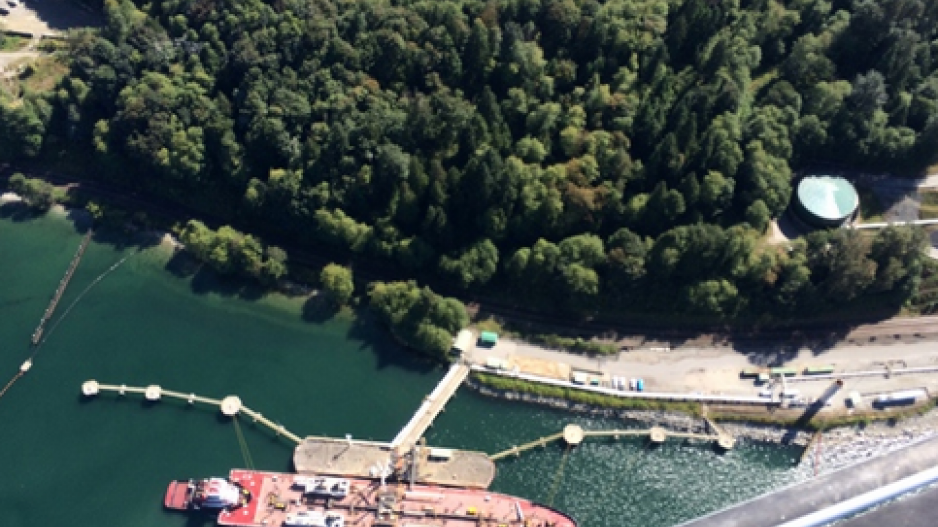The proposal by Kinder Morgan to expand its Trans Mountain pipeline does not take into consideration the potential impacts on wildlife, according to a study commissioned by the Tsleil-Waututh Nation, the City of Vancouver and the Living Oceans Society.
The report, Fate and Effect of Oil Spills from the Trans Mountain Expansion Project in Burrard Inlet and the Fraser River Estuary, argues that more than one million birds are vulnerable to the effects of a possible spill and more than 100,000 of these animals could die as a result.
Birds are not the only animals at risk, the study found.
“Substantial numbers of marine mammals, especially Harbour seals and Harbour porpoise, could perish, and the viability of the endangered southern resident killer whale population could be jeopardized, elevating their risk of extinction,” the City of Vancouver said in a release May 18.
The study, written by Dr. Jeffrey Short, an international authority on the effects of oil spills, will be presented to the National Energy Board May 27as part of the Trans Mountain Pipeline hearing.
The study comes just three days after the release of an oil-spill mapping study, which was commissioned by the City of Burnaby, the City of Vancouver and the Tseil-Waututh Nation.
This study found that in a worst-case scenario in the event of an oil spill in the Burrard Inlet with no cleanup, up to 90% of the oil would reach the shore within hours.
“Of the many severe risks posed by the proposed Kinder Morgan expansion, the potential for spills in Burrard Inlet has always been a huge concern for the City of Burnaby,” Burnaby Mayor Derek Corrigan said in a joint press release. “Though the pipeline would end in Burnaby, the risks clearly would extend far beyond Burnaby’s boundaries to all of the municipalities bordering Burrard Inlet – and ultimately to all those who use, value and benefit from our thriving harbor and the innumerable economic, environmental and recreational benefits it provides. This report illustrates why the project Kinder Morgan is proposing can never be allowed on our coast.”
Genwest Systems conducted the study, using a two-dimensional mapping system. The study covered spill scenarios, assuming there would be no cleanup efforts, in four locations: the First Narrows, the Second Narrows, the Westridge Marine Terminal and the outer harbour. In all four scenarios, 50 to 90 per cent of the oil would reach the shorelines within hours.
The study was released with an animated video, showing how a First Narrows spill would spread throughout the Inlet, as far as Port Moody, in 72 hours. The First Narrows spill scenario was for 16 million litres of crude, which represents 20 per cent of the load for a typical oil tanker filling up at Kinder Morgan’s Westridge Marine Terminal in Burnaby.
The study also reviewed Kinder Morgan’s own oil spill trajectory model and found it was a reasonable representation of a spill, but there were “at least two serious shortcomings.”
The first is that Kinder Morgan’s study did not account for the fact that beached oil generally gets washed back into the water and spreads more. The second shortfall was the spill model for the Westridge Marine Terminal in Burnaby was unrealistic because it assumed the containment boom would be in place and working, therefor creating a much smaller spill scenario. Assuming the containment boom will be 100 per cent effective is inappropriate and “not the historical norm,” according to the report.
The Tsleil-Waututh Nation, which is based on the North Shore but has traditional territory in Burnaby, released its own video. It shows eight days following a spill of 8,000 cubic metres of oil at the Westridge terminal, assuming there would be no cleanup. The video shows Burnaby's north shore coated in oil, as the tides wash crude in and out of the Inlet.
Kinder Morgan spokesperson Ali Hounsell said the company stands by its assessments but would analyze the new report.
“We’ll be doing a more detailed review of it. It’s a pretty lengthy report,” she said. “The main things one has to ask … is that they’ve considered things like spill response. Did they consider that Western Canada Marine Response Corporation is there and would respond to the spill or is it completely unmitigated?”
(The report’s executive summary stated the four scenarios were based on the assumption there was no cleanup.)
Hounsell said the report was all part of the NEB hearing process.
“We know intervenors have the option to generate their own evidence and present it, and it will be considered by the NEB closely, and we will review it as well. At the end of the day, if people can produce evidence that we think can improve our project, I’m sure will look at that and the NEB will as well,” she said.
Kinder Morgan’s application to twin the Trans Mountain pipeline, which runs oil from Alberta to Burnaby, is before the National Energy Board. The proposal includes expanding the Burnaby Mountain tank farm and the marine terminal, where tankers fill up with crude.
Vancouver, Burnaby and the Tsleil-Waututh are all intervenors in the hearing, and the jointly-commissioned study is part of the evidence they’re filing on May 27.
The oil spill study comes on the heels of a damning report issued by Burnaby’s deputy fire chief on tank farm safety, which will also be entered as evidence. Both Burnaby and Vancouver are collecting residents’ concerns on the proposed pipeline expansion.
- With files from Jennifer Moreau, Burnaby Now
[email protected]



